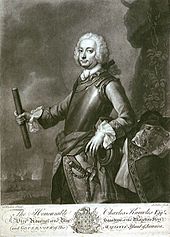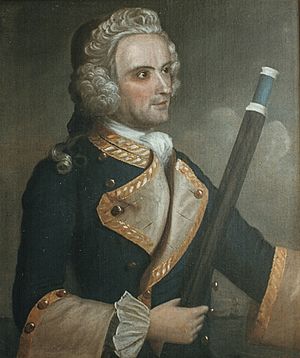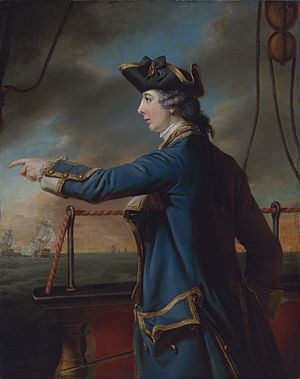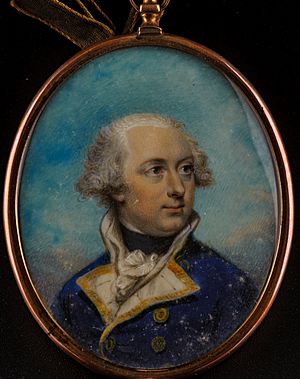Sir Charles Knowles, 1st Baronet facts for kids
Quick facts for kids
Sir Charles Knowles, Bt
|
|
|---|---|
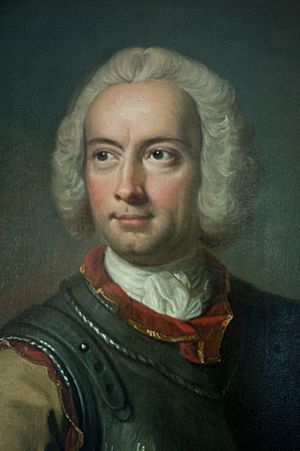
Sir Charles Knowles
|
|
| Born | c.1704 |
| Died | 9 December 1777 (aged 72–73) Bulstrode Street, London |
| Allegiance | |
| Service/ |
|
| Years of service | 1718–1774 |
| Rank | Admiral |
| Commands held | HMS Diamond HMS Success HMS Lichfield HMS Weymouth HMS Suffolk Commander-in-Chief, Barbadoes and Leeward Islands Commander-in-Chief, Jamaica |
| Battles/wars | Battle of Cape Passaro Battle of Cartagena de Indias Battle of La Guaira Battle of Puerto Cabello Battle of Havana |
| Spouse(s) | Mary, |
| Relations | Charles Knowles (son) Edward Knowles (son) |
Sir Charles Knowles (born around 1704, died December 9, 1777) was a skilled British naval officer. He served in the Royal Navy during several big wars. These included the War of Jenkins' Ear, the War of the Austrian Succession, and the Seven Years' War.
Later in his life, he also worked for the Imperial Russian Navy. He became an Admiral during his long career. He was known for being very smart, especially in building and destroying forts.
Most of his naval career was spent in the West Indies (the Caribbean Sea). There, he led ships and fought against Spanish and French forces. Even with a busy navy life, Knowles kept studying. He translated scientific papers and invented new things. Sometimes, his career had tough moments. This might be why he moved to Russia later to help build their navy. He is also linked to the Knowles Riot in British America.
Contents
Charles Knowles was likely born around 1704. Some people think he was the son of Charles Knowles, the Earl of Banbury. His half-brother, Lord Wallingford, helped him get a good education.
Knowles joined the navy in March 1718. He was recommended to Admiral Sir George Byng. Knowles first served on the ship HMS Buckingham. Then, in April, he moved to HMS Lenox. He stayed on the Lenox until December 1720, serving with Byng's fleet in the Mediterranean Sea. He was at the Battle of Cape Passaro in 1718.
In 1721, Knowles was assigned to HMS Lyme. He spent most of this time studying on land. After returning to Britain, he served on several ships. He became a lieutenant in May 1730 on the small ship HMS Tryall. He then returned to the Lion in 1731. This ship went to the West Indies.
Adventures in the West Indies
Knowles became known as a great engineer. He helped plan the Westminster Bridge in London. He even traveled to France to study bridges there.
In 1737, he became captain of HMS Diamond. He joined Admiral Edward Vernon's fleet in the West Indies in 1739. This was during the War of Jenkins' Ear. Knowles captured two Spanish ships on his way. One ship carried a lot of money and supplies.
Knowles arrived at Portobelo after Vernon's victory. Vernon gave him the job of destroying the Spanish forts. This was hard work because the forts were very strong. It took three weeks and a lot of gunpowder. Knowles impressed Vernon with his skills on land.
Vernon then sent Knowles to watch Cartagena. Knowles was given command of special ships. He attacked the fortress of San Lorenzo at the mouth of the Chagres River. The town and castle gave up in March 1740. Knowles was made Governor of the castle. He then destroyed the castle as ordered.
The Battle of Cartagena de Indias
Knowles returned to England in 1740. He then took command of HMS Lichfield and later HMS Weymouth. He sailed back to the West Indies in October 1740.
In February 1741, Knowles helped plan a big attack on Cartagena. He led the operations to scout the Spanish defenses. He then helped lead the attack. He stormed and captured a fort, took the Spanish flagship, and broke through the harbor's defenses. This allowed the British fleet to enter.
Knowles helped destroy enemy batteries and captured the Castillo Grande fort. Vernon made him governor of Castillo Grande. Knowles then destroyed the fort when the British left. The British did not capture Cartagena. This caused arguments between the army and navy. Knowles wrote a pamphlet in 1743 that criticized the army.
After this, Knowles worked to make forts and ship facilities better. He improved bases at Port Antonio, Port Royal, and Antigua. He became known as a hero for his engineering work. He is sometimes called the "Father of Britain's Caribbean naval bases." He became a commodore, a high rank, after this.
Battles of La Guaira and Puerto Cabello
In 1742, Knowles took command of HMS Suffolk. In 1743, he was ordered to attack Spanish towns. These were La Guaira and Puerto Cabello. The Spanish governor knew about the plans. He got more defenders and gunpowder.
So, an attack on La Guaira in March 1743 failed. Knowles tried to attack Puerto Cabello twice in April. Both attacks were also stopped. Knowles ended the mission and went back to Jamaica.
Governor of Louisbourg
Between 1743 and 1745, Knowles captured many enemy ships. His success was praised by important people in Jamaica. During this time, he also designed the first British Tower in the West Indies. This was the 1745 River Fort Barbuda. It was an early version of the later Martello Tower.
In 1746, Knowles became captain of the new ship HMS Devonshire. He returned to Britain later that year. In 1746, he was given command of a squadron. He briefly checked on French invasion plans. He then captured two French ships.
In spring 1746, he became governor of Louisbourg. He sailed there in March 1746. He spent almost two years as governor. He worked hard to fix and improve the forts there. His troops fought in one battle, the Battle at Port-la-Joye.
Knowles was very impressed by the brave defense of Fort at Number 4 in 1747. He gave a special sword to Captain Phinehas Stevens. Later, the town was named Charlestown in honor of Charles Knowles.
He was promoted to rear-admiral in July 1747. He became commander in chief of the Jamaica Station. He planned to attack Santiago de Cuba. But bad winds made him change his mind. He attacked Fort Saint Louis de Sud instead. He captured the fort in March 1748. Knowles was promoted again in May 1748. He tried to capture Santiago de Cuba again but failed.
Battle of Havana and Court-Martial
After his ships were repaired, Knowles went looking for a Spanish treasure fleet. He found the fleet in September 1748. But there was confusion with signals. The British fleet did not attack in an organized way.
The Battle of Havana ended with one Spanish ship captured and another damaged. But it was not the big victory hoped for. Knowles was accused of managing the battle poorly. He faced a court-martial in December 1749. He was criticized for his tactics. This caused bad feelings between Knowles and his officers. Some officers even fought duels. King George II had to step in and stop any more duels.
Governor of Jamaica
Knowles was a Member of Parliament for a short time. In 1752, he became Governor of Jamaica. In 1754, a group called the Maroons rebelled. Knowles stopped the rebellion and captured its leader. The Maroon town, Charles Town, Jamaica, was named after Knowles.
As governor, he tried to improve the legal system. He also moved the capital from Spanish Town to Kingston. He thought Kingston was easier to defend. His actions caused some people to want him removed. But the British government supported his policies. Knowles resigned in January 1756 and returned to England. He was promoted to vice-admiral in February 1755. He was offered a special honor but turned it down. Later, he accepted a baronetcy, which made him Sir Charles Knowles.
In 1756, the Cuban governor invited Knowles to visit Havana. Havana was a very strong Spanish base. Knowles accepted and spent time memorizing details of Havana’s defenses. He later drew up plans to capture Havana. These plans were used when the British captured Havana in 1762.
Later Service and Russia
Knowles was second in command during the Rochefort Expedition in 1757. This was during the Seven Years' War. The expedition was not successful. Knowles was criticized for his actions. He wrote a pamphlet to defend himself.
In 1758, the French government offered Knowles a lot of money. They wanted his secret recipe for curing beef and pork. This recipe helped prevent scurvy, a disease common on long sea voyages. Knowles refused to sell it to the French. He also refused money from his own government. He then published the recipe. This changed how beef and pork were prepared for sea travel. He was promoted to full admiral in 1760. He became a baronet in 1765.
Admiral of the Russian Fleet
In 1770, Knowles left the British navy. He accepted an offer from Catherine the Great of Russia. She made him a first admiral in her fleet. He was to help improve the Imperial Russian Navy. It was in bad shape during the war against Turkey.
Knowles worked in an administrative role. He oversaw ship construction and supplies in all Russian ports. He was based in St Petersburg until 1774. Then he returned to England.
By the time he left Russia, he had done a lot. He made a plan to rebuild the navy like the English navy. He oversaw the building of at least five new warships. One ship, the Ezekial, was built in just 8.5 months. Normally, it took up to five years to build a ship like it. He also helped create a strong Black Sea squadron. He rebuilt a dry dock and a new canal.
In 1773, he brought steam technology from Scotland to Russia. This was to pump water from a dry dock. This was 26 years before the British navy used a steam engine for this purpose. His work with steam engines helped grow interest in steam power in Russia. People called him the "Father of the Russian Navy."
Family and Personal Life
Knowles married Mary in 1740. They had a son named Edward Knowles. Edward also joined the navy. But he was lost at sea in 1762 when his ship disappeared.
Knowles married a second time in 1750 to Maria Magdalena Therese de Bouget. They had one son, Charles Knowles, and two daughters. One daughter, Anna Charlotte Christiana Knowles, went with her father to Russia. She became a favorite of Empress Catherine.
Knowles translated a book about how floating objects move. He also invented a device to measure wind pressure and speed. He was a true reformer. He wrote to Admiral Anson about ship building and how to treat timber. His ideas were ahead of his time.
In 1758, Knowles published a recipe for curing beef and pork. This helped prevent scurvy, a terrible disease for sailors. He also suggested a plan to help the navy find more sailors. He wanted to build affordable homes for navy families near dockyards. This would have made it easier for the navy to get people to join.
Knowles was still working on his ideas before he died. He was looking for someone to help him with his experiments and writings. He died in London on December 9, 1777. He was buried in Guildford, Surrey.
Two towns are named after him: Charlestown, New Hampshire and Charles Town, Jamaica.
See also
- Knowles Riot
- Knowles Baronets
- Knollys family
 In Spanish: Charles Knowles para niños
In Spanish: Charles Knowles para niños


